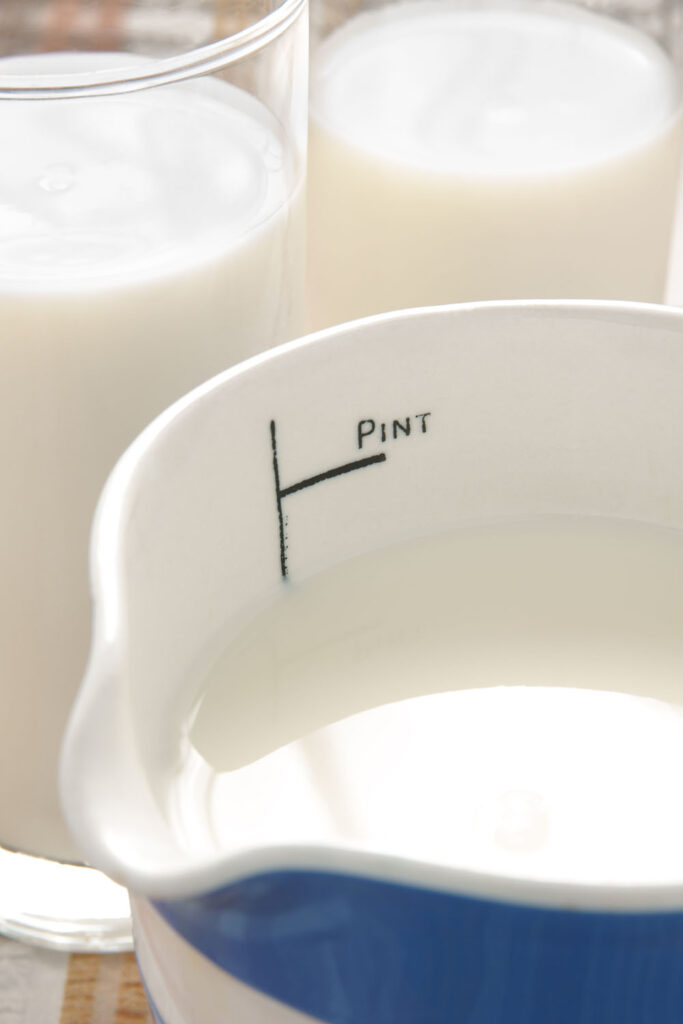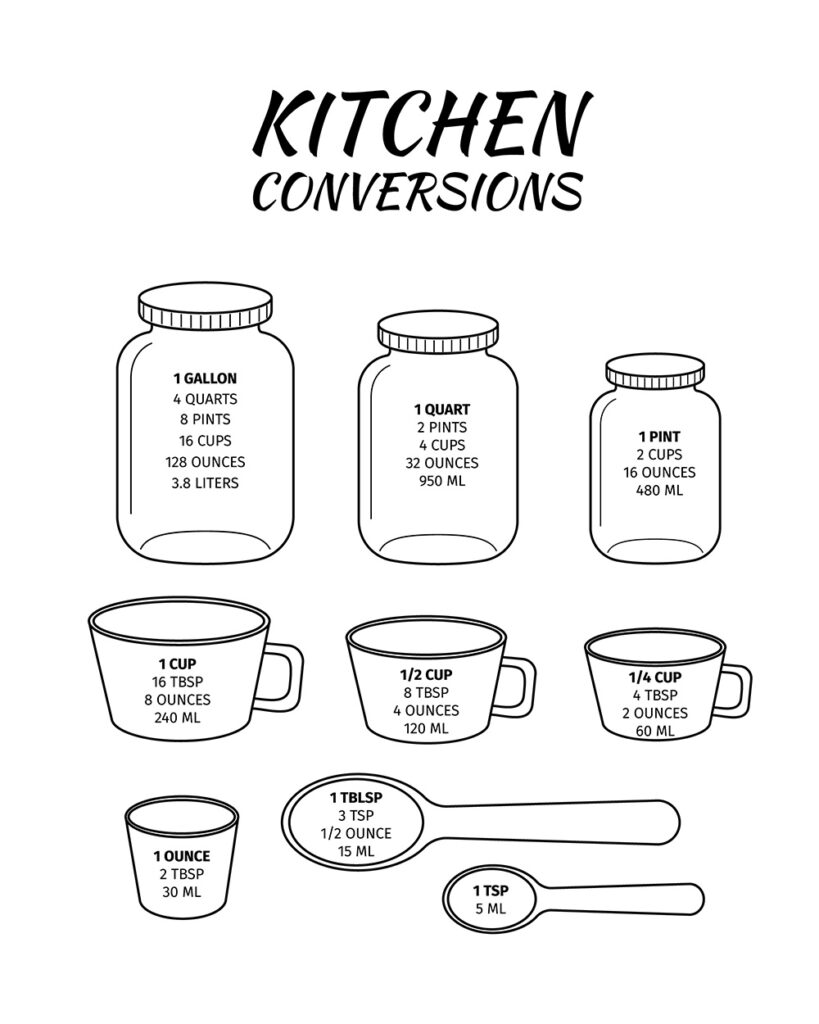Cups are cool and all, but let’s be real: they sometimes might not be the precision masters we need in baking recipes.

Readers have been hitting me up to ask about the whole pint-to-cup conversion. Great news: it’s a piece of cake (literally!) Stick around, and I’ll spill all the juicy details for you.
How Many Cups Are Equal To 1 Pint?
A pint measurement clocks itself at 16 fluid ounces or a neat 2 cups.
A bit of fun fact: the word “pint” takes a trip through French (“pinte”) and maybe a little Latin (“pincta”), hinting at painted markings on containers during ancient times. Back in Rome, a pint equaled 1/8 of a gallon because, you know, eights used to be their measurement standards.
And just in case you’re feeling a bit rushed and need a quick conversion, here’s my all-time favorite cheat sheet:
| Pint | Fluid Ounces | Cups |
| ½ pint | 8 ounces | 1 cup |
| 1 pint | 16 ounces | 2 cups |
| 2 pint | 32 ounces | 4 cups |
| 3 pint | 48 ounces | 6 cups |
| 4 pint | 64 ounces | 8 cups |
| 5 pint | 80 ounces | 10 cups |
| 6 pint | 96 ounces | 12 cups |
| 8 pint | 128 ounces | 16 cups |
| 10 pint | 160 ounces | 20 cups |
Is There Any Difference Between Pints From The US and UK?
I must say the US pint and its British cousin, the Imperial pint, aren’t exactly peas in a pod. The US pint is like the little sibling, a bit smaller (around 20%, to be precise). While a US pint shakes hands with 16 ounces, the UK pint is the life of the 20-ounce bash.
Long story short, 1 US liquid pint = 2 cups. But hop across the pond, and it’s a slightly different story: 1 UK liquid pint = 2.409 cups.
Still, if you prefer cup measurements, the difference between 2 and 2.409 cups isn’t a big deal for most. So you can pretty much treat them as kitchen buddies! Easy peasy, right?
How Many Cups Are In A Gallon, Pound, or Quart?
1 gallon equals 16 cups, while 1-quart rolls in with 4 cups!
I know the whole US vs. UK unit of measurement can be a head-scratcher. But if you’re a cup person (not exactly the ruler of precision), there’s no need to stress too much about it. Here’s a helpful chart to help you breeze through the conversions:
| Quart | Gallon | Cups |
| 1 quart | ¼ gallon | 4 cups |
| 2 quarts | ½ gallon | 8 cups |
| 3 quarts | ¾ gallon | 12 cups |
| 4 quarts | 1 gallon | 16 cups |
| 5 quarts | 1 ¼ gallons | 20 cups |
| 6 quarts | 1 ½ gallons | 24 cups |
| 7 quarts | 1 ¾ gallons | 28 cups |
| 8 quarts | 2 gallons | 32 cups |

How about the pound-to-cup versions? Hold on tight because this one’s a bit trickier than the rest. Why? Cups are all about volume, while pounds are on team weight!
And do not forget that different ingredients play by their own rules. They have different densities, so a cup of one thing won’t necessarily match the weight of a cup of something else.
Take flour and sugar, for example. A cup of flour is like a feather compared to a cup of sugar because flour is just not as dense. Similarly, a cup of water carries more weight than a cup of oil since water likes to flex its density muscles!
So, obviously, I can’t possibly dish out the conversions for every existing ingredient in this chart. But hey, I’ve got you covered with some of the usual options; check out my handy formula:
| Pound | Ingredients | Cups (Approximately) |
| 1 pound | Honey | 1.3 cups |
| 1 pound | Syrup | 1.3 cups |
| 1 pound | Butter | 2.0 cups |
| 1 pound | Liquid Coffee | 2.0 cups |
| 1 pound | Sour Cream | 2.0 cups |
| 1 pound | Uncooked Rice | 2.2 cups |
| 1 pound | Olive Oil | 2.3 cups |
| 1 pound | Granulated Sugar | 2.3 cups |
| 1 pound | Brown Sugar | 2.3 cups |
| 1 pound | Powdered Sugar | 3.6 cups |
| 1 pound | Cake Flour | 3.8 cups |
| 1 pound | Cocoa Powder | 4.5 cups |
Extra Tips To Measure Ingredients Accurately

For Dry Ingredients
When dealing with dry ingredients like cornmeal, sugar, or flour, grab a dry measuring cup and hold it over waxed paper or a canister paper, then lightly sprinkle in those dry goodies until the cup is overflowing.
Next, level it off by swiping your metal spatula (or a flat butter knife) right across the top. This is especially important when you’re in the flour game!
For Wet/Liquid Ingredients
There’s a whole game plan for liquids and dry ingredients, so make sure you’ve got both dry and liquid measuring cups in your kitchen arsenal!
Now, place your liquid measurement cup on a flat surface, then eyeball it at your eye level for a spot-on measure. Don’t lift the cup for a check; that’s a no-go and not to mention unnecessary. Some of the newer liquid measurement cups are conveniently designed so you can read them accurately from above.
How about those sticky, wet ingredients like honey or molasses? Well, I just need to hit my measuring cup with a little cooking spray. It’ll make pouring and cleaning up a breeze!
Conclusion
The whole cups-to-pints (or vice versa) conversion is a breeze, and you don’t even have to sweat about the British vs. American pint showdown. The same goes for gallons and quarts; easy peasy!
Now, pounds, they play hard to get, so just skip the cup drama and grab a kitchen scale if you can. It will be a much smoother ride, trust me!







